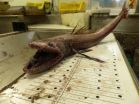(Press-News.org) CORVALLIS, Ore. – Exposure to iron pipes and steel rebar, such as the materials found in most hatcheries, affects the navigation ability of young steelhead trout by altering the important magnetic "map sense" they need for migration, according to new research from Oregon State University.
The exposure to iron and steel distorts the magnetic field around the fish, affecting their ability to navigate, said Nathan Putman, who led the study while working as a postdoctoral researcher in the Department of Fisheries and Wildlife, part of OSU's College of Agricultural Sciences.
Just last year Putman and other researchers presented evidence of a correlation between the oceanic migration patterns of salmon and drift of the Earth's magnetic field. Earlier this year they confirmed the ability of salmon to navigate using the magnetic field in experiments at the Oregon Hatchery Research Center. Scientists for decades have studied how salmon find their way across vast stretches of ocean.
"The better fish navigate, the higher their survival rate," said Putman, who conducted the research at the Oregon Hatchery Research Center in the Alsea River basin last year. "When their magnetic field is altered, the fish get confused."
Subtle differences in the magnetic environment within hatcheries could help explain why some hatchery fish do better than others when they are released into the wild, Putman said. Stabilizing the magnetic field by using alternative forms of hatchery construction may be one way to produce a better yield of fish, he said.
"It's not a hopeless problem," he said. "You can fix these kinds of things. Retrofitting hatcheries with non-magnetic materials might be worth doing if it leads to making better fish."
Putman's findings were published this week in the journal Biology Letters. The research was funded by Oregon Sea Grant and the Oregon Department of Fish and Wildlife, with support from Oregon State University. Co-authors of the study are OSU's David Noakes, senior scientist at the Oregon Hatchery Research Center, and Amanda Meinke of the Oregon Hatchery Research Center.
The new findings follow earlier research by Putman and others that confirmed the connection between salmon and the Earth's magnetic field. Researchers exposed hundreds of juvenile Chinook salmon to different magnetic fields that exist at the latitudinal extremes of their oceanic range.
Fish responded to these "simulated magnetic displacements" by swimming in the direction that would bring them toward the center of their marine feeding grounds. In essence, the research confirmed that fish possess a map sense, determining where they are and which way to swim based on the magnetic fields they encounter.
Putman repeated that experiment with the steelhead trout and achieved similar results. He then expanded the research to determine if changes to the magnetic field in which fish were reared would affect their map sense. One group of fish was maintained in a fiberglass tank, while the other group was raised in a similar tank but in the vicinity of iron pipes and a concrete floor with steel rebar, which produced a sharp gradient of magnetic field intensity within the tank. Iron pipes and steel reinforced concrete are common in fish hatcheries.
The scientists monitored and photographed the juvenile steelhead, called parr, and tracked the direction in which they were swimming during simulated magnetic displacement experiments. The steelhead reared in a natural magnetic field adjusted their map sense and tended to swim in the same direction. But fish that were exposed to the iron pipes and steel-reinforced concrete failed to show the appropriate orientation and swam in random directions.
More research is needed to determine exactly what that means for the fish. The loss of their map sense could be temporary and they could recalibrate their magnetic sense after a period of time, Putman said. Alternatively, if there is a critical window in which the steelhead's map sense is imprinted, and it is exposed to an altered magnetic field then, the fish could remain confused forever, he said.
"There is evidence in other animals, especially in birds, that either is possible," said Putman, who now works for the National Oceanic and Atmospheric Administration. "We don't know enough about fish yet to know which is which. We should be able to figure that out with some simple experiments."
INFORMATION: END
Iron, steel in hatcheries may distort magnetic 'map sense' of steelhead
2014-06-04
ELSE PRESS RELEASES FROM THIS DATE:
Two planets orbit nearby ancient star
2014-06-04
Washington, D.C.— An international team of astronomers, including five Carnegie scientists, reports the discovery of two new planets orbiting a very old star that is near to our own Sun. One of these planets orbits the star at the right distance to allow liquid water to exist on its surface, a key ingredient to support life. Their work is published by Monthly Notices of the Royal Astronomical Society.
Kapteyn's Star, named after the Dutch astronomer, Jacobus Kapteyn, who discovered it at the end of the 19th century, is the second fastest-moving star in the sky and belongs ...
Deep sea fish remove 1 million tonnes of CO2 every year from UK and Irish waters
2014-06-04
Deep sea fishes remove and store more than one million tonnes of CO2 from UK and Irish surface waters every year, according to a new study led by the University of Southampton.
This natural carbon capture and storage scheme could store carbon equivalent to £10 million per year in carbon credits.
Fish living in deep waters on the continental slope around the UK play an important role carrying carbon from the surface to the seafloor.
It is assumed that deep water fishes all depend on particles that fall from the surface for their energy. These bottom-living deep water ...
The Lancet Psychiatry: Study shows increasing rates of premature death and violent crime in people with schizophrenia since 1970s
2014-06-04
New research, published in The Lancet Psychiatry journal, shows that rates of adverse outcomes, including premature death and violent crime, in people with schizophrenia are increasing, compared to the general population.
The results come from a unique study, led by Dr Seena Fazel, at Oxford University, UK, which analyses long-term adverse outcomes – including conviction for a violent crime (such as homicide or bodily harm) premature death (before the age of 56), and death by suicide – between 1972 and 2009 in nearly 25,000 people in Sweden diagnosed with schizophrenia ...
Pneumococcal conjugate vaccine is effective for preventing community-acquired pneumonia
2014-06-04
A 10-valent pneumococcal conjugate vaccine (PCV) is effective in reducing the number of new cases of likely-bacterial community-acquired pneumonia in infants in Latin America, according to a study published in this week's PLOS Medicine. Xavier Sáez-Llorens and colleagues from Department of Infectious Diseases, Panama found that the 10-valent PCV reduced the number of new cases of likely-bacterial community-acquired pneumonia in infants by 22% (95% CI: 7.7, 34.2) compared to those who received the control vaccine in the per-protocol cohort at the pre-planned interim analysis ...
Place and cause of death in centenarians: A population-based observational study in England
2014-06-04
Centenarians are more likely to die of pneumonia and frailty or "old age" and less likely to die of the chronic conditions often associated with old age, such as cancer or ischemic heart disease, compared with older adults younger than 100 years, according to a study by Catherine Evans and colleagues from King's College London, London, UK. Centenarians were most likely to die in a care home (61%) or hospital (27%) and less likely to die at home (10%) or in hospice care (0.2%). Higher care bed capacity was associated with fewer deaths of centenarians in hospital.
The ...
New health services needed for rise in 100-year-olds
2014-06-04
Over 35,000 people lived to 100 years or more in England over the last ten years, with a large proportion subsequently dying from frailty exacerbated by pneumonia, according to a new study by King's College London. With the number of centenarians set to grow, end-of-life care needs to be tailored to the increasing frailty in this age group, warn the King's palliative care researchers. Boosting care home capacity and planning health services for the rise in centenarians could help to reduce reliance on hospital admission at the end of life and ensure a better quality of ...
Unexpected diversity of egg yolk proteins play a key role in ant sociality and castes
2014-06-04
The social insects, including bees, wasps, ants and termites have developed a highly advanced society where division of labor amongst workers to serve the queen's reproduction has long fascinated biologists who have wanted to uncover the molecular pathways driving the complex behavior of insect societies.
In the advanced online edition of Molecular Biology and Evolution, Claire Morandin et al. performed molecular evolutionary analyses on the egg yolk forming protein, Vitellogenin (Vg), and its many forms, amongst seven Formica ant species. Vitellogenin is known to play ...
Discovering a hidden source of solar surges
2014-06-04
Cutting-edge observations with the 1.6-meter telescope at Big Bear Solar Observatory (BBSO) in California have taken research into the structure and activity of the Sun to new levels of understanding. Operated by New Jersey Institute of Technology (NJIT), the telescope at Big Bear is the most powerful ground-based instrument dedicated to studying the Sun.
A group of astronomers led by Dr. Santiago Vargas Domínguez has analyzed the highest- resolution solar observations ever made. A summary of their work at BBSO was presented on June 2 at the 224th meeting of the American ...
New device isolates most aggressive cancer cells
2014-06-04
ITHACA, N.Y. – Not all cancer cells are created equal – some stay put in the primary tumor, while others move and invade elsewhere. A major goal for cancer research is predicting which cells will metastasize, and why.
A Cornell cancer research team is taking a new approach to screening for these dangerous cells, using a microfluidic device they invented that isolates only the most aggressive, metastatic cells.
"The approach we've taken is a reverse approach from what is conventionally done," said Cynthia Reinhart-King, associate professor of biomedical engineering and ...
Many breast cancer patients don't get treatment for heart problems
2014-06-03
Only a third of older breast cancer patients saw a cardiologist within 90 days of developing heart problems, in a study presented at the American Heart Association's Quality of Care and Outcomes Research 2014 Scientific Sessions.
Breast cancer patients with heart problems who saw a cardiologist were more likely to receive standard therapy for their heart failure than those who did not see a heart specialist, the study found.
"The majority of older women who develop heart problems after their breast cancer therapy aren't treated by a cardiologist, and they had lower ...


